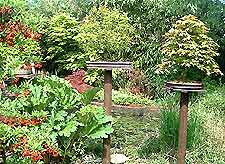Bonsai Trees
Leaf Pruning

The main reasons for leaf pruning deciduous bonsai trees are to produce a smaller crop of new leaves, to let light reach the inner and lower branches and to gain an extra year's growth. With a second flush of new leaves, the autumn colour is also improved.
Next year's buds will be activated and therefore the development of the bonsai is rapidly speeded up. Damaged or scorched leaves can be replaced with fresh new leaves, weak areas of branches can receive more light and ventilation, and spring can be enjoyed all over again!
The principal behind this effective technique is to encourage a new set of leaves after the spring leaves have hardened off and become 'leathery'. Therefore, the bonsai is still strong enough to leaf out again, but lacks the initial burst of spring energy to produce large leaves and when dormant buds are activated, smaller leaves result. Only healthy trees which have previously been well fed and are growing strongly should ever receive this treatment. However, any feeding should be stopped two-three weeks before initiating this procedure so that large leaves do not reappear.
Flowers and fruit will always remain the same size as a naturally growing tree and cannot be reduced, so be selective when choosing species for training as bonsai, opting for trees and shrubs that produce small flowers and berries. Trees with big flowers and fruit will appear more in scale when grown as larger bonsai.
Leaf pruning guidelines:
- Correct timing is a vital factor and early summer is ideal. Do not leaf prune after this time or the tree may not re-leaf
- Cut off leaves so that the leaf stalk is left behind. These will fall off as the new buds at the base begin to swell
- Zelkovas have no leaf stalk and these are the only tree where leaves can be carefully pulled off by hand. Do not pull leaves from any other species as it is likely that the leaf stalk will also be removed, together with the bud that needs to be activated
- Normally, all leaves should be removed, although foliage can be left on weaker branches that require extra strength. With the rest of the tree being bare, these remaining leaves draw the tree's energy into the branch and weak areas will quickly respond
- Always remove growing tips, otherwise the shoot will continue to extend and the desired back budding may not occur
- When the tree has been leaf pruned, its demand for water will drop and so it should be watered accordingly
- Once leaf pruned, position the tree in full sun for at the least the first few weeks, to encourage strong budding
- Only leaf prune strong, healthy trees. If a tree has been leaf pruned for several years consecutively, it will benefit from not defoliating for a year
- Leaf prune only once a year. This is a demanding technique and the tree will need time to fully recover
- Most trees should be in full leaf sometime between four-six weeks after leaf pruning
- Partial defoliation is another version of this technique. Large, outer leaves are removed and in vigorous areas such as the top, foliage masses can be greatly thinned. Zelkovas respond particularly well to this treatment and this can be repeated again several weeks later if necessary, providing that the tree has fully recovered
- If a tree does not leaf back, do not despair. Leaves will probably reappear in spring, but do not leaf prune the next year. Failure to leaf out can be caused by the tree being initially too weak at the time of defoliation, the removal of the leaves may have been too late in the year or the tree may have not received adequate sunlight afterwards
 The main reasons for leaf pruning deciduous bonsai trees are to produce a smaller crop of new leaves, to let light reach the inner and lower branches and to gain an extra year's growth. With a second flush of new leaves, the autumn colour is also improved.
The main reasons for leaf pruning deciduous bonsai trees are to produce a smaller crop of new leaves, to let light reach the inner and lower branches and to gain an extra year's growth. With a second flush of new leaves, the autumn colour is also improved.